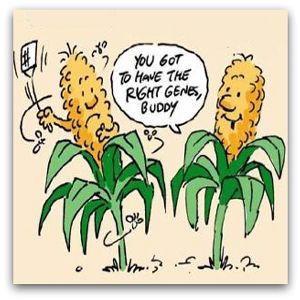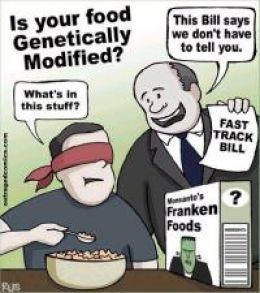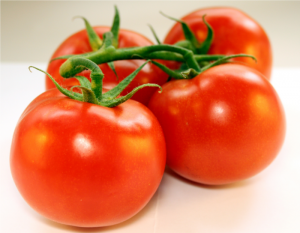Are Genetically Modified Foods Safe?
I will go over what it means for food to be Genetically Modified (GM), the pros and cons, and let you weigh the benefits and risks. I believe that it’s important to learn the facts and allow yourself to make an educated decision.
Genetically Modified Defined
This statement, from the World Health Organization (WHO), explains what “Genetically Modified” means:
” Genetically modified organisms (GMOs) can be defined as organisms in which the genetic material (DNA) has been altered in a way that does not occur naturally. The technology is often called “modern biotechnology” or “gene technology”, sometimes also “recombinant DNA technology” or “genetic engineering”. It allows selected individual genes to be transferred from one organism into another, also between non-related species.”
What does this all mean? Anything that isn’t completely natural, and has been modified through scientific means, is considered Genetically Modified (GM).
Why Genetically Modified Foods are Produced 
There is no denying that there are advantages to having Genetically Modified foods produced, otherwise we wouldn’t bother with it in the first place, right? Here are some of the advantages:
Pest Resistance -Farmers can lose a lot of produce from insects and pests, and in the past they would drench their crops with harmful pesticides. Well, many crops still use pesticides on their produce, but many are now turning to Genetically Modified foods such as “B.t. corn”, which is a corn that reduces the need for pesticides and minimizes farmer’s cost.
Drought/Salinity Tolerance – With Genetically Engineered plants, farmers can grow crops in areas that normally wouldn’t be able to produce a good crop. These plants can now survive droughts or land and water that may contain a high salt content.
Herbicide Tolerance – Weeds are a big problem for home owners, so just imagine what farmers have to go through! It can be quite expensive and time consuming to get rid of weeds, so crops can be Genetically Engineered to be resistance to powerful herbicides. This means that the farmers can use less of their toxic herbicides on their crop, and still kill the weeds while the crop remains unharmed.
Cold Tolerance – If there is an unexpected frost, it can be detrimental for a new crop. Plants have been Genetically Engineered to have an antifreeze gene – which actually came from cold water fish! – which allows the plants to be able to tolerate cold temperatures that would normally destroy the plant.
Disease Resistance- Yes, plants have diseases too! They can have a variety of bacterias, viruses, and fungi that can ruin a crop. Plant Biologists are creating Genetically Engineered crops that are resistant to being sick.
Pharmaceuticals- Afraid of shots? What if you could just have an edible vaccine? Researchers are working on creating edible vaccines to provide to third world countries, since they are easier to ship, store, and administer, when compared to injectable vaccines.
Why Activists are Against Genetically Modified Foods
In addition to the many pros that I mentioned earlier about Genetically Modified Foods, we simple can’t ignore the cons to this new technology.
There are a lot of things that we still don’t know about Genetically Modified foods, such as the effects on our health with long term consumption. Of course, many scientists have an idea.
I have found a source which lists over 50 studies that link GMO foods to anywhere from allergy-related deaths to even cancer and other diseases. This is something I encourage you to look into. There is a lot of information, there are reputable studies that deserve a look.
“Swapping genes between organisms can produce unknown toxic effects and allergies that are most likely to affect children.” -Vyvyan Howard, expert in infant toxico-pathology at Liverpool University Hospital, United Kingdom
From what we do know about Genetically Modified foods so far, there are over 800 scientists and doctors throughout the World who have written and signed an Open Letter to all the Governments concerning the use of Genetically Modified Organisms (GMO). After checking out the concerns, studies, and data gathered…they definitely have my full attention!
In 2007, Arpad Pusztai, a scientist from the Rowett Research Institution in the UK, announced that his experiments with rats had shown intestinal changes by eating genetically engineer potatoes. Pusztai said that because of his findings, he would not eat such modified foods and discouraged it’s use. Unfortunately, Pusztai was removed from his job. Interestingly enough, because of the public’s reaction, there were a lot of changes made. Major supermarket chains announced that they would stop selling Genetically Modified foods. Even international companies such as Cadburys-Schweppes and Nestlé, stopped using Genetically Engineered products.
You may wonder how Genetically Modified plants effect our planet and those we share it with. There have been some studies that show Genetically Modified crops (in addition to herbicides and practicing mono-culture) have a negative effect on honey bees. Over the last decade, there has been a significant decrease in the honey bee population, which is a concern we need to take notice of soon.
“Is My Food Genetically Modified?”
Right now, the United States Government prevents GMO labeling, which means that if food in the grocery store is Genetically Modified, the company legally doesn’t have to tell you. As a consumer, I believe that we all have the right to know what kind of food we are buying.
With seven out of every ten items at the grocery store Genetically Modified, a lot of us are unknowingly consuming GM foods. It’s important to know how to tell which foods are Genetically Modified, and which ones are not.
Here are some ways to help you buy Non-GMO foods, if that’s a choice you would like to make:
•Find foods that feature a “Non-GMO” label. There is also a Non-GMO Project Verified Seal, which lets you know that at-risk ingredients have been tested for GMO content, and are safe.
•Buy foods that are Certified as Organic.
•Check out this Non-GMO Shopping Guide that was created. It lets you know which products are most likely Genetically Modified, and which foods are not likely to be. The guide is quite helpful, I was able to learn that seedless Watermelons, for example, are not a Genetically Modified food!
•Avoid Processed foods, since most of these (about 70%) tend to contain foods that have been Genetically Modified.
•Check out the PLU Code on the little stickers that come on your fruit and vegetables. The numbers will let you know if your fruit or vegetable is Conventionally Grown, Organically Grown, or Genetically Modified!
-Conventionally Grown: Has four numbers on it, such as “1033”
-Organically Grown: Has five numbers on it, with a “9” in the beginning, such as “91033”.
-Genetically Modified: Has five numbers on it, with an “8” in the beginning, such as “81033”.
Do the Benefits Outweigh the Risks?
It’s important for you to understand the pros and cons so you can make an educated decision for yourself, since it can make an impact on your health.
If I have a choice, I personally will choose Non-GMO foods. Let’s just say that I like things as natural as they were intended to be.
Now it’s your turn to make a decision. Ever heard of the phrase “Actions speak louder than words”? It’s important to realize that you vote for or against Genetically Modified foods every day…with your dollar.
Image Credits: ProGMO; AntiGMO
Feel free to follow us, however you like: Google+, Facebook, Twitter, Pinterest


